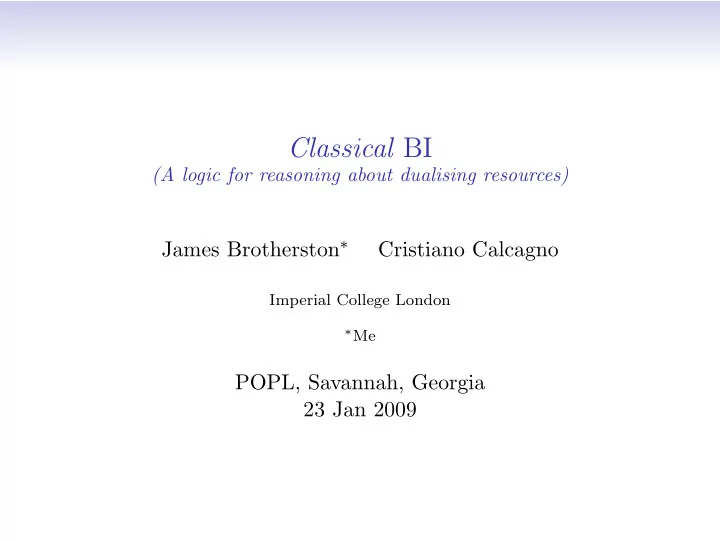

Classical BI (A logic for reasoning about dualising resources) James Brotherston ∗ Cristiano Calcagno Imperial College London ∗ Me POPL, Savannah, Georgia 23 Jan 2009
Boolean BI (O’Hearn and Pym ’99) • A substructural logic with natural resource interpretation. • Formula connectives: Additive: ⊤ ⊥ ¬ ∧ ∨ → Multiplicative: ⊤ ∗ ∗ — ∗ • Additives are interpreted classically.
Resource models of BBI • Models of BBI are relational commutative monoids � R, ◦ , e � (we assume ◦ a partial function), where: R: a set of resources ◦ : a way of (partially) combining resources e: the distinguished empty resource • Separation logic is based on a BBI-model of heaps. • Multiplicative formulas talk about resources r ∈ R : r | = ⊤ ∗ ⇔ r = e r | = F 1 ∗ F 2 ⇔ r = r 1 ◦ r 2 and r 1 | = F 1 and r 2 | = F 2 ∀ r ′ . r ◦ r ′ defined and r ′ | = F 1 implies r ◦ r ′ | r | = F 1 — ∗ F 2 ⇔ = F 2
Our contribution: classical BI ( CBI ) • Why aren’t there multiplicative versions of ⊥ , ¬ , ∨ ? • We obtain CBI by adding them to BBI: Additive: ⊤ ⊥ ¬ ∧ ∨ → Multiplicative: ⊤ ∗ ⊥ ∼ ∗ ∨ ∗ — ∗ ∗ and considering multiplicatives to behave classically.
Problems • Does a logic like CBI even make any sense? • How do we interpret the new connectives? • Is there a nice proof theory? • What are the potential applications?
Dualising resource models of CBI • A CBI-model is given by a tuple � R, ◦ , e, − , ∞� , where: • � R, ◦ , e � is a BBI-model; • ∞ ∈ R and − : R → R ; • for all r ∈ R , − r is the unique solution to r ◦ − r = ∞ . • Natural interpretation: models of dualising resources. • Every Abelian group is a CBI-model (with ∞ = e ). • We interpret ⊥ ∗ , ∼ , ∗ ∨ as follows: r | = ⊥ ∗ ⇔ r � = ∞ r | = ∼ F ⇔ − r �| = F = F 1 ∗ r | ∨ F 2 ⇔ r | = ∼ ( ∼ F 1 ∗ ∼ F 2 )
Example: Personal finance • Let � Z , + , 0 , −� be the Abelian group of integers (money): • m | = F means “ £ m is enough to make F true”. • Let C / W be the formulas “I’ve enough money to buy cigarettes / whisky” . “£ m is enough to buy both cigarettes m | = C ∗ W ⇔ and whisky” “I owe less than the price of m | = ∼ C ⇔ a pack of cigarettes” “so long as I don’t spend more than m | = C ∗ ∨ W ⇔ the price of cigarettes, I can definitely still buy whisky”
Proof theory • We give a display calculus proof system, DL CBI , for CBI. • Display calculi are essentially generalised sequent calculi, with an enriched meta-level. • Main technical results about DL CBI : Theorem (Cut-elimination) Any DL CBI proof can be transformed into a cut-free proof. Theorem (Soundness) Any DL CBI -derivable proof judgement is valid. Theorem (Completeness) Any valid proof judgement is DL CBI -derivable.
Applications of CBI : what cannot be done Proposition CBI is a non-conservative extension of BBI . That is, there are formulas of BBI that are valid wrt. CBI but not BBI . • Separation logic heap model does not extend to a CBI-model. • Consequence: we cannot (directly) apply CBI reasoning principles such as F — ∗ G ≡ ∼ F ∗ ∨ G to the heap model. • Look for applications where resources are naturally dualising.
A CBI -model of financial portfolios • Let ID be an infinite set of identifers. • Let P be the set of portfolios: functions p : ID → Z s.t. p ( x ) � = 0 for only finitely many x ∈ ID . • Define composition +, involution − and empty portfolio e : ( p 1 + p 2 )( x ) = p 1 ( x ) + p 2 ( x ) ( − p )( x ) = − p ( x ) e ( x ) = 0 • � P, + , e, −� is an Abelian group, thus also a CBI-model.
Credit crunch solved! Let A ( x ) represent a portfolio consisting of asset x . Then ∼¬ A ( x ) represents a portfolio consisting of liability x .
Summary of CBI Model theory: based on involutive commutative monoids • multiplicatives are classical • a non-conservative extension of BBI Proof theory: a display calculus gives us: • cut-elimination • soundness • completeness Applications: reasoning about dualising resources, e.g.: • money; • permissions; • bi-abduction.
Recommend
More recommend